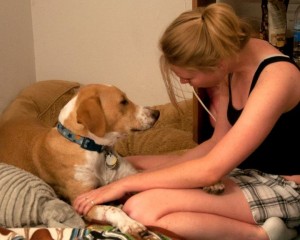Micahel Baugh CPDT-KSA, CDBC
Change is sometimes subtle, even imperceptible. There was a time when Tad was labeled “aggressive,” barking, and lunging at people he didn’t know. Tad had bitten, for humans the worst offense a dog can commit. Hope ran thin for Tad. The idea that he’d ever be a “typical dog” seemed a far way off. Change, it seemed, would have to be dramatic.
Tiffany had found Tad in an awful state. He’d been dumped on the side of a country road to wither and die. Tad had done the former and was well on his way to the latter when Tiffany scooped him up and took him home. He gained weight and healed well. Then the trouble started.
Tiffany called Tad’s behavior “going ape shit.” She works at a vet clinic and Tad had been going with her every day. Whenever Tad saw a new person (mostly clients) he would “go ape shit.” I wondered exactly what Tiffany meant, so I asked. She sent me video. There was Tad, behind a baby gate barking and jumping and lunging toward someone just off camera. I’m not one for labels; just tell me what the dog is doing. Still, Tiffany’s label was apt. She told me that Tad had bitten her father, and that she was worried Tad would bite again (he did). So, we set an appointment and a week later I drove nearly an hour to meet Tad.

I never saw Tad behave poorly other than in that video. If I do my job right with so-called aggression cases, I never see the behavior. That was how it went with Tad. We met at a friend’s training facility, then a few weeks later at the clinic, then a few more times after that. Tad and I became fast friends, and that’s certainly the way I like it. I like Tad. In another life he’s the dog I’d live with. That’s saying something. I don’t fall for all my clients the way I fell for Tad.
All the while, Tiffany and I stayed in close contact. It wasn’t always easy. I worried. I woke up in the middle of the night thinking about Tad. I texted and emailed Tiffany to make sure she was on track.
She and I butted heads once (my fault). I got frustrated and forgot my golden rule: the client is not my enemy. Tad had bitten a delivery man and I feared we’d lost our way altogether. On paper this was an easy case. When it started to play out, it wasn’t easy at all. That’s how it goes sometimes. It’s the way it went with Tad.
Assess the risk to the dog and to other dogs and humans. Lay out a good training plan. Communicate the plan well. Restate the plan often. Provide a safe and caring relationship for the client. Remember behavior is driven by the environment. Change the environment even a little and the behavior will change in turn. Those are the rules, except there’s one more. Believe. Follow the rules and believe. The rest will follow. That’s the way it went with Tad.
No one ever calls and says my dog is better. It doesn’t happen very often, anyway. Change is rarely dramatic. What happens instead is that as the dog improves his guardian relaxes and stops calling. That’s a tricky time for me as a teacher and a coach. How is Tad? Why isn’t she calling? Some clients get lax and fall back into a bad pattern of behavior with their dog. (Yes, that happened in this case). But, once real change starts to settle in the pattern of training and monitoring the dog’s behavior just becomes part of everyday life. Things get better and no one really pays any notice. Typical is boring, right? That’s what happened with Tad.
He goes to work with Tiffany still, but not with his housemate dogs. That one little change helped a great deal. Tad greets people well and shows just about everyone the real self he showed me. Tiffany remains vigilant, knowing that teaching her dog is a life-long proposition. Change came subtly. It was almost imperceptible, but change came.
It’s been a while since I’ve seen Tad. Tiffany and I have been talking for several weeks with nothing much to report. Tad is doing fine, no more incidents, making progress on his rowdy play, otherwise pretty boring. I was waiting for the other shoe to drop, but it didn’t. I knew it was coming time to close the case, and tentatively put a check in the win column with Tad’s name on it. Tiffany and I discussed this, and agreed. My work is done for now.
I think of Tad and the road where Tiffany first found him. They’ve come so far from the suffering and the tears. Now, there are so many more roads yet to explorer. That’s the way it goes with people and their dogs. Another adventure into the unknown, except for the one thing they each know for sure. They’re in this together.


